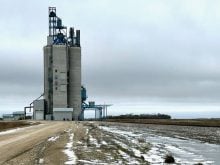MONTREAL – Canada’s largest ethanol producer is interested in building a plant in the West as soon as producers start growing energy crops.
“That is where the future is going to be and I can’t wait for it to happen,” said Ken Field, chair of Greenfield Ethanol.
Greenfield operates five corn ethanol plants in Ontario and Quebec and is keenly interested in expanding into the prairie region once second generation ethanol technologies are ready for commercialization.
“As soon as the technology develops, we’ll be out in Western Canada talking to farmers,” said Field during a break in the Biofuels International Canada Expo & Conference.
Read Also

Internet of Things tapped for better emissions insights
Interconnected field sensor fleet allows better soil monitoring coverage and, hopefully, live insights on farm greenhouse gas emissions and nitrogen fertilizer application for farms.
“It’s going to be a partnership between ourselves and the farmers and the government of Saskatchewan in order to be able to put together the whole program for us to have a huge plant out there to manufacture ethanol for Saskatchewan but probably for export as well.”
Field said firms in Canada and the United States are “right on the cusp” of commercializing cellulose ethanol technology, which turns crop biomass into fuel. He expects plants to be operating in 18 to 24 months.
“Once they prove out, people are going to run into this business,” he said.
Jordan Solomon, president of Ecostrat, believes miscanthus should be the leading energy crop for producing what is being termed “grassoline” and for other renewable energy initiatives.
Miscanthus is a rapid-growing grass that can reach four metres tall on marginal land. Stands re-grow each year for 15 to 20 years.
Planting costs are steep because it has to be grown from greenhouse plugs. Solomon estimated the costs for genetics and planting would cost a farmer $950 an acre.
But once it’s in the ground, the costs are minimal. Miscanthus is a nitrogen-fixing crop, which means there are no fertilizer expenses and it has no known pests, so there are no pesticide expenses. And because it can be grown on marginal soil, land costs are minimal.
Solomon sees cost certainty as the main benefit of the emerging energy crop. It allows firms such as his to provide ethanol companies such as Greenfield with a fixed price for their raw material extending 15 to 20 years into the future.
The other main benefit is the crop’s high yield. By the third year of production miscanthus delivers 10 to 12 bone-dry tonnes of biomass per acre. Solomon said that is twice the yield of its main competitor, switchgrass.
There are numerous miscanthus research trials being conducted across Canada. Ontario has the most advanced trials because there could be a near-term market for the crop in that province.
Ontario Power Generation (OPG), an electricity company, has committed to stop firing coal at four of its plants by December 2013.
The company predicts it will need 10 million tonnes of locally grown biomass feedstock annually to replace the coal.
OPG will decide by the second quarter of 2010 whether miscanthus will be one of its sources of raw material.















